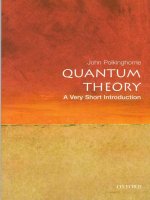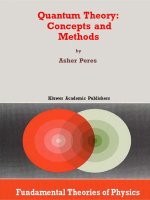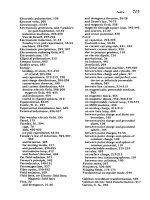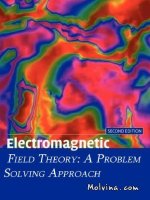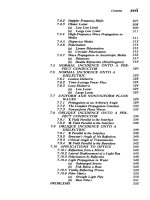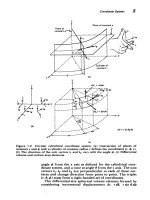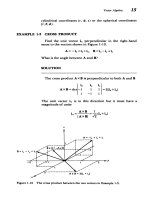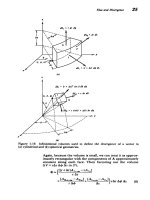- Trang chủ >>
- Khoa Học Tự Nhiên >>
- Vật lý
Interpreting quantum theory; a therapeutic approach
Bạn đang xem bản rút gọn của tài liệu. Xem và tải ngay bản đầy đủ của tài liệu tại đây (2.19 MB, 217 trang )
New Directions in the Philosophy of Science
Series Editor: Steven French, Professor of Philosophy of Science,
University of Leeds, UK
The philosophy of science is going through exciting times. New and productive relationships are being sought with the history of science. Illuminating and innovative
comparisons are being developed between the philosophy of science and the philosophy of art. The role of mathematics in science is being opened up to renewed scrutiny
in the light of original case studies. The philosophies of particular sciences are both
drawing on and feeding into new work in metaphysics, and the relationships between
science, metaphysics, and the philosophy of science in general are being re-examined
and reconfigured.
The intention behind this new series from Palgrave Macmillan is to offer a new, dedicated publishing forum for the kind of exciting new work in the philosophy of science
that embraces novel directions and fresh perspectives.
To this end, our aim is to publish books that address issues in the philosophy of science
in the light of these new developments, including those that attempt to initiate a
dialogue between various perspectives, offer constructive and insightful critiques, or
bring new areas of science under philosophical scrutiny.
Titles include:
THE APPLICABILITY OF MATHEMATICS IN SCIENCE
Indispensability and Ontology
Sorin Bangu
THE PHILOSOPHY OF EPIDEMIOLOGY
Alex Broadbent
PHILOSOPHY OF STEM CELL BIOLOGY
Knowledge in Flesh and Blood
Melinda Fagan
INTERPRETING QUANTUM THEORY
A Therapeutic Approach
Simon Friederich
SCIENTIFIC ENQUIRY AND NATURAL KINDS
From Planets to Mallards
P. D. Magnus
COMBINING SCIENCE AND METAPHYSICS
Contemporary Physics, Conceptual Revision and Common Sense
Matteo Morganti
COUNTERFACTUALS AND SCIENTIFIC REALISM
Michael J. Shaffer
ARE SPECIES REAL?
An Essay on the Metaphysics of Species
Matthew Slater
www.pdfgrip.com
MODELS AS MAKE-BELIEVE
Imagination, Fiction and Scientific Representation
Adam Toon
Forthcoming titles include:
SCIENTIFIC MODELS AND REPRESENTATION
Gabriele Contessa
New Directions of the Philosophy of Science
Series Standing Order ISBN 978–0–230–20210–8 (hardcover)
(outside North America only)
You can receive future titles in this series as they are published by placing a standing
order. Please contact your bookseller or, in case of difficulty, write to us at the address
below with your name and address, the title of the series and the ISBN quoted above.
Customer Services Department, Macmillan Distribution Ltd, Houndmills, Basingstoke,
Hampshire RG21 6XS, England
www.pdfgrip.com
Interpreting Quantum
Theory
A Therapeutic Approach
Simon Friederich
www.pdfgrip.com
© Simon Friederich 2015
All rights reserved. No reproduction, copy or transmission of this
publication may be made without written permission.
No portion of this publication may be reproduced, copied or transmitted
save with written permission or in accordance with the provisions of the
Copyright, Designs and Patents Act 1988, or under the terms of any licence
permitting limited copying issued by the Copyright Licensing Agency,
Saffron House, 6–10 Kirby Street, London EC1N 8TS.
Any person who does any unauthorised act in relation to this publication
may be liable to criminal prosecution and civil claims for damages.
The author has asserted his right to be identified as the author of this work
in accordance with the Copyright, Designs and Patents Act 1988.
First published 2015 by
PALGRAVE MACMILLAN
Palgrave Macmillan in the UK is an imprint of Macmillan Publishers Limited,
registered in England, company number 785998, of Houndmills, Basingstoke,
Hampshire RG21 6XS.
Palgrave Macmillan in the US is a division of St Martin’s Press LLC,
175 Fifth Avenue, New York, NY 10010.
Palgrave Macmillan is the global academic imprint of the above companies
and has companies and representatives throughout the world.
Palgrave® and Macmillan® are registered trademarks in the United States,
the United Kingdom, Europe and other countries.
ISBN: 978–1–137–44714–2
This book is printed on paper suitable for recycling and made from fully
managed and sustained forest sources. Logging, pulping and manufacturing
processes are expected to conform to the environmental regulations of the
country of origin.
A catalogue record for this book is available from the British Library.
A catalog record for this book is available from the Library of Congress.
www.pdfgrip.com
To Sibylla, Alma, and Lydia
www.pdfgrip.com
www.pdfgrip.com
Contents
Series Editor’s Foreword
x
Preface
xii
Part I
Introduction and Background
1
Introduction
1.1 Quantum foundations
1.2 The idea of a therapeutic approach
1.3 Outline of this work
3
3
6
8
2
Sketch of the Formalism
2.1 The Hilbert space formalism
2.2 Measurement and collapse
2.3 Many-component systems and entanglement
13
13
18
21
3
Interpretations as Solutions to the Measurement Problem
3.1 Exposition of the problem
3.1.1 Maudlin’s formulation
3.1.2 A fallacious solution
3.2 Additional parameters
3.2.1 Pilot wave theory
3.2.2 Alternatives: modal interpretations
3.3 Schră
odinger time-evolution not universal?
3.3.1 From Wigner to Penrose
3.3.2 The GRW model
3.4 No determinate outcomes
3.4.1 Defining branches
3.4.2 How do probabilities fit into the picture?
26
26
26
29
31
31
37
38
39
40
41
42
44
Part II The Rule Perspective
4
Motivating a Therapeutic Approach
4.1 Absence of the foundational problems
in practice
4.2 Philosophy as therapy
4.3 Quantum states as non-descriptive
4.3.1 Dissolving the measurement problem
vii
www.pdfgrip.com
49
49
50
53
54
viii Contents
4.4
5
6
4.3.2 Collapse as update
4.3.3 Types of epistemic accounts
Space-time structure and collapse
In Search of a Viable Epistemic Account
5.1 Knowledge of probabilities versus probabilities as
degrees of belief
5.2 Quantum Bayesianism
5.2.1 Probabilities as subjective
5.2.2 Values of observables as subjective?
5.3 Objectivity of observables measured in an epistemic
account of states
5.4 Constitutive rules
Quantum Probabilities: What Are They?
6.1 Probabilities of what?
6.2 Probabilities of what kind?
6.2.1 Relative frequencies?
6.2.2 Propensities?
6.2.3 Objective probabilities as constraints on
rational credences
6.3 Objections to this interpretation of probabilities
6.3.1 The means/ends objection
6.3.2 The quantum Bayesian Moore’s paradox
55
56
58
61
61
62
62
64
68
71
75
75
79
80
82
84
85
85
87
Part III Objections
7
Copenhagen Reloaded?
7.1 Bohr and ‘classical language’
7.2 Heisenberg and the epistemic conception of
quantum states
7.2.1 Heisenberg on pure versus mixed states
7.2.2 Heisenberg on quantum probabilities as
‘objective tendencies’
102
8
The Charge of Anthropocentrism
8.1 Bell’s criticism
8.2 Anthropocentric notions and value determinateness
105
105
108
9
Reduction and Explanation
9.1 The micro/macro divide
9.2 Explanation without ontic quantum states
113
113
115
www.pdfgrip.com
95
96
99
99
Contents ix
Part IV Non-locality, Quantum Field
Theory, and Reality
10
11
12
Non-locality Reconsidered
10.1 Quantum theory and special relativity – again
10.2 Formulating local causality
10.2.1 Causation and counterfactuals
10.2.2 Local causality probabilistically
10.3 The Principal Principle and admissible evidence
10.4 Intuitive probabilistic local causality in the language
of the Principal Principle
10.5 Quantum theory, local causality, and the Principal
Principle
10.6 But how does nature perform the trick?
125
125
127
129
132
136
A Look at Quantum Field Theory
11.1 Lagrangian versus algebraic quantum
field theory
11.2 Basics of the algebraic approach
11.3 ‘Pristine’ interpretations
11.4 The Rule Perspective and unpristine interpretations
11.5 The case for an unpristine interpretation
146
Quantum Theory and ‘Reality’
12.1 Instrumentalism?
12.2 Sharp values for all observables?
12.3 Conclusion
157
158
161
166
139
141
143
146
147
148
150
152
Appendices
Appendix A
Sketch of Bell’s Theorem
168
Appendix B
The Kochen–Specker Theorem in a Nutshell
172
Appendix C
The Pusey–Barrett–Rudolph (PBR) Theorem – A Short
Introduction
175
Notes
178
Bibliography
187
Index
197
www.pdfgrip.com
Series Editor’s Foreword
The motivation behind our series is to create a dedicated publishing
forum for the kind of exciting new work in the philosophy of science that embraces novel directions and fresh perspectives. To this end,
our aim is to publish books that address issues in the philosophy of
science in the light of these new developments, including those that
attempt to bring new areas of science under philosophical scrutiny, initiate a dialogue between competing perspectives, or explore and develop
distinctive new approaches.
Simon Friederich has written an exciting and provocative book that
tackles the so-called measurement problem in quantum physics in a new
and thought-provoking way. His overall philosophical stance is ‘therapeutic’, in a Wittgensteinian sense, whereby foundational problems are
effectively dissolved by pointing out that they arise from certain conceptual confusions. In this particular case, Friederich argues that the
confusion surrounds the notion of ‘state’ in quantum mechanics. Standardly, this term is taken to represent an objective feature of quantum
systems, thus generating the problem of how to account for what we
observe at the ‘everyday’ level given the ‘entangled’ states presented by
quantum mechanics. If we drop this standard understanding and regard
such states as reflecting our epistemic condition, so that the distinction between the quantum level and the everyday can be seen as a shift
in our epistemic situation, then, Friederich insists, the problem simply
dissolves.
Crucial to this approach is Searle’s notion of a ‘constitutive rule’, in
the sense of a rule that constitutes a particular activity (as in the case
of the game of chess, for example). According to Friederich, to assign
a state to a physical system in accordance with the rules of quantum
mechanics is simply what it means to perform such a state assignment
correctly, so that this assignment is logically dependent on those rules.
This ‘Rule Perspective’ offers an entirely novel stance on the foundations of quantum physics and Friederich sets it in the context of
a carefully articulated review of both the relevant formalism and the
most well-known interpretations of the theory, including the currently
much-discussed ‘Many Worlds View’. He also contrasts it with ‘quantum
Bayesianism’, which is found to be wanting insofar as it cannot account
x
www.pdfgrip.com
Series Editor’s Foreword xi
for our knowledge of observables. A detailed account of how probabilities should be understood in quantum mechanics is then developed
from the standpoint offered by the ‘Rule Perspective’.
Friederich also carefully considers a range of possible objections to his
approach. One is that it is just the infamous Copenhagen interpretation
re-heated, but he notes the differences, as well as similarities, with the
views of Bohr and Heisenberg. Another has to do with accommodating
the extensive empirical success of quantum theory and Friederich shows
how this can also be accounted for within his epistemic view. Finally,
he tackles Bell’s charge that such views amount to a form of anthropocentrism by articulating which uses of anthropocentric notions are
legitimate in this context.
The book concludes by examining the implications of this approach
for three further issues: non-locality, the foundations of quantum field
theory, and scientific realism. In his final words, Friederich insists that
it is not only what we learn from quantum theory about reality that is
intriguing and fascinating but also how we do so.
Friederich’s book represents a bold new approach to an old and muchdiscussed problem. It offers clearly articulated and powerful arguments
for the dissolution of this problem and a re-orientation of our view of
quantum physics in general. In this way it takes the field in a new and
exciting direction. It is precisely the sort of work that the editorial board
and I aim to support through the New Directions series and we are sure
that it will have a major impact on both philosophers of science and
philosophically reflective physicists.
Steven French
Professor of Philosophy of Science
University of Leeds
www.pdfgrip.com
Preface
This book develops and explores what I call a ‘therapeutic’ approach to
the foundational problems of quantum theory. It considers and develops the idea that quantum states do not represent any objective features
of the quantum systems they are assigned to without denying that there
are objective standards of correctness that govern the application of
quantum theory to the world.
All the essential ingredients of my work on quantum theory in the
past few years are combined (and further developed) in this work. Trying to formulate an account in the ‘therapeutic’ spirit just mentioned I
have profited greatly from enormously helpful suggestions by many colleagues and friends. In particular, I would like to thank Andreas Bartels,
who supervised my work on a thesis that eventually turned into this
book. I am also grateful to Jeremy Butterfield, Michael Esfeld, Robert
Harlander, Richard Healey, Koray Karaca, Felix Mă
uhlhă
olzer, Thorben
Petersen, Patrick Plă
otz, Gregor Schiemann, and Chris Timpson for the
lively and inspiring exchanges I had with them on some of the topics treated here. Further useful comments on earlier versions of (what
developed into) parts of this book were provided by anonymous referees of various journals and of Palgrave Macmillan. I would also like to
thank the participants of the Gă
ottinger Philosophisches Reflektorium
as well as audiences in Heidelberg, Wuppertal, Bern, Gă
ottingen, Bonn,
Cambridge, Hanover, and Munich for numerous (partly very critical)
valuable comments and suggestions. Most of all, I would like to thank
my wife Andrea Harbach for her encouragement and our continuing
marital dialogue.
While working on the ‘therapeutic’ approach to quantum theory presented here I had the immeasurable luck of welcoming my beloved
daughters Sibylla, Alma, and Lydia (in order of appearance) to their lives.
They have made my life so much richer while I have been working on
this book, which is why I dedicate it to them.
Acknowledgements for permission
Some of the chapters of this book contain more refined and developed
versions of earlier works. I acknowledge permission to reuse material
that appeared for the first time in:
xii
www.pdfgrip.com
Preface xiii
•
•
•
•
•
How to spell out the epistemic conception of quantum states. Studies
in History and Philosophy of Modern Physics, 42:149–157, 2011.
In defence of non-ontic accounts of quantum states. Studies in History
and Philosophy of Modern Physics, 44:77–92, 2013.
Quantum theory as a method: The Rule Perspective. In T. Sauer and
A. Wă
uthrich, editors, New Vistas on Old Problems: Recent Approaches
to the Foundations of Quantum Mechanics, pages 121–138. Edition
Open Access. Max Planck Research Library for the History and
Development of Knowledge, 2013.
Interpreting Heisenberg interpreting quantum states. Philosophia
Naturalis, 50:85–114, 2013.
Pristinism under pressure: Ruetsche on the interpretation of quantum
theories. Erkenntnis, 78:1205–1212, 2013.
www.pdfgrip.com
www.pdfgrip.com
Part I
Introduction and Background
www.pdfgrip.com
www.pdfgrip.com
1
Introduction
1.1 Quantum foundations
Quantum theory is perhaps the theory with the greatest predictive and
explanatory success in all the history of physics. To name just a few of
its countless achievements: it explains the stability of the stable atoms
and nuclei and predicts the decay rates of the unstable ones; it accounts
for the different manifestations of matter such as gaseous, liquid and
solid, metallic and insulating, magnetic, superfluid and superconducting; it forms the basis of our chemical knowledge; and it provides the
conceptual framework of all contemporary models for the fundamental
constituents of matter. In addition, some of its predictions, for example
that of the ‘electron spin g-factor’ in quantum electrodynamics, are perhaps the most accurate ones ever made in the history of science. Some
of its predictions concern matter at extremely high energy and interactions between bits of matter at extremely short distances; others are
about matter at extremely low energy and close to the zero of absolute
temperature. As far as its technological applications are concerned, its
insights are at the heart of the overwhelming technological progress in
information technology in the past few decades, it explains why nuclear
fission and fusion work as they do, and it forms the basis of the rapidly
growing field of nanotechnology.
However, all of quantum theory’s stupendous predictive and explanatory achievements notwithstanding, the debates about its foundations
are more hotly contested than ever. In fact, the majority view among
philosophers of physics, accurately summarised by David Wallace, is
that quantum theory ‘is the great scandal of physics; despite [its] amazing successes, we have no satisfactory physical theory at all – only an
ill-defined heuristic which makes unacceptable reference to primitives
3
www.pdfgrip.com
4 Interpreting Quantum Theory: A Therapeutic Approach
such as “measurement”, “observer” and even “consciousness”’ (Wallace
[2008], p. 16). Most philosophers of physics would agree that quantum
theory either needs to be modified and replaced by a different theoretical framework, or that it requires an interpretation which leads to a
picture of the world that is radically at odds with our everyday views.
The most prominent examples of theories designed to replace quantum theory are pilot wave theory (‘Bohmian mechanics’) and GRW
theory. The most famous speculative interpretations, which lead to a
radical breaking with our everyday views, are the variants of the Everett
interpretation, including the so-called many-worlds and many-minds
interpretations. Their core idea is that our world is (or our minds are)
constantly subject to ubiquitous branching processes, and that what
we take to be the actual world (or our actual mind) is just one among
countless many world (or mind) branches.
A few decades ago, the debate about the foundations of quantum
theory was still shaped by widespread commitment to the so-called
Copenhagen interpretation. Whatever exactly this interpretation actually
says, one of its few clear-cut tenets (perhaps the only one) is that
quantum theory is complete as an internally sound physical theory and
requires neither modification nor re-interpretation in speculative terms.
Almost all philosophers of physics would now reject this view.1 Their
main reason for regarding the Copenhagen interpretation as untenable
(whatever exactly it says) can be summarised roughly as follows:
The Copenhagen interpretation must either embrace the ‘collapse of
the wave function’ as one of quantum theory’s crucial constituents (for
introductory comments on the collapse of the wave function see Section
2.2) or reject it.2 If it rejects collapse, the Copenhagen interpretation
cannot account for the manifest – and empirically trivial – fact that measurement processes always result in determinate outcomes. It is then
empirically inadequate in the most blatant way possible. If, in contrast, the Copenhagen interpretation accepts collapse, it must specify
under which conditions collapses occur, but without resorting to such
vague, ambiguous and anthropocentric notions as ‘measurement’ and
‘observer’. These are inadequate in the context of supposedly fundamental physical theories and may therefore not be used to specify the
criteria for the occurrence of collapse. Since neither Bohr nor Heisenberg
nor Pauli nor Dirac nor any other supposed adherent of the Copenhagen
interpretation seems to have proposed a coherent alternative to this fatal
dilemma, it follows that the Copenhagen interpretation – whatever it
actually says – is deeply unsatisfying; or so contemporary philosophers
of physics essentially seem to agree.
www.pdfgrip.com
Introduction 5
The difficulty of accounting for determinate measurement outcomes
in quantum theory is an aspect of the famous measurement problem.
Almost all suggested modifications and interpretations of quantum theory can be seen as attempts to solve the measurement problem. They
are naturally categorised (as I will show in Chapter 3) according to how
they react to this problem.
The measurement problem is not the only substantial foundational
challenge in quantum theory. Another arises from what is widely known
as ‘quantum non-locality’: the fact that quantum theory predicts correlations between measurement outcomes which obtain independently of
the spatio-temporal distance between the outcomes and which it does
not explain in terms of common causes. Bell’s theorem (for a sketch see
Appendix A) shows that these correlations are incompatible with theories that respect a criterion that Bell takes to incorporate the idea of ‘local
causality’: that causal influences cannot travel faster than light and probabilities depend only on what occurs in regions from which influences
at velocities no larger than the velocity of light can arrive. Superluminal
influences are widely regarded as problematic in the relativistic context,
mainly due to the fact that they are backwards in time in some inertial
frames.
Thus, in view of Bell’s result, quantum theory and relativity theory
seem to clash at least in spirit (if not in letter) in a very profound and
seemingly unavoidable way. Since the correlations predicted by quantum theory are experimentally well-confirmed, the pressure, according
to many authors, is on relativity theory here. Some authors go as
far as considering the revival of a space-time framework which contains a universally privileged inertial rest frame in terms of which an
absolute simultaneity relation among space-time events would be
defined.3 If this conclusion were the right one to draw, one of the main
lessons of relativity theory – that all inertial frames are on an equal conceptual footing – would have to be unlearned, and the symmetries that
are regarded as principled in relativity theory would be downgraded to
merely apparent and emerging rather than fundamental.
In conclusion, it appears that reflections on the foundations of quantum theory have the potential to undermine our confidence not only in
quantum theory itself, but also in relativity theory. So, these reflections
shake our faith in the two main elements of our contemporary understanding of physics without providing any clear ideas as to what should
replace them. Is there any way to avoid this devastating result?
www.pdfgrip.com
6 Interpreting Quantum Theory: A Therapeutic Approach
1.2 The idea of a therapeutic approach
The aim of the present work is to probe a specific way of answering this
question with a ‘yes, it can be avoided’. The hypothesis that I wish to
explore is that the foundational problems require neither revising quantum theory or relativity theory nor any extravagant metaphysics. The
idea which motivates this investigation is that both the measurement
problem and the problem of quantum non-locality are mere artefacts
of conceptual confusions that disappear once the actual role of the
elements of the quantum theoretical formalism in its applications is
properly taken into account. I refer to this type of approach as ‘therapeutic’, as it tries to ‘cure’ us from what it takes to be unfounded worries
that arise from conceptual confusion.
The idea of philosophy as a form of intellectual therapy has a long
tradition (one may trace it back to Epicurus in antiquity). In the
more recent history of philosophy it is advocated in particular by the
later Wittgenstein. The therapeutic approach to philosophical problems
is a core element of the radically innovative conception of philosophy he develops and puts to work in his Philosophical Investigations
(Wittgenstein [1958]). Wittgenstein’s suggested strategy for dissolving
philosophical problems is to reflect on the actual context and mode of
use of the concepts involved, i.e. their roles in our ‘language games’,
and to investigate whether, in order to formulate the problems, they
are perhaps used in ways in which they cease to make good sense. Typically, the Wittgensteinian diagnosis is that the source of a perceived
philosophical problem is that one had naively – and mistakenly, as it
turns out – assumed that the concepts involved in its formulation are
used descriptively (or, more specifically, as more or less directly representing features of reality), which in fact they are not.4 Examples
of Wittgensteinian therapeutic analyses include his account of mental concepts such as ‘pain’ (see, e.g., (Wittgenstein [1958] § 244)) and
his account of mathematical language as normative rather than descriptive.5 In both cases, his ambition is to make the philosophical problems
associated with these concepts disappear by constantly reminding us of
their actual, ‘everyday’ (Wittgenstein [1958] § 116), use.
The present work applies the idea of philosophy as therapy to the
foundational problems of quantum theory. With respect to the measurement problem, the most straightforward strategy for dissolving it is
to suggest that the core quantum theoretical vocabulary – namely, quantum states – is actually used non-representationally, contrary to what is
usually assumed. Whether or not this view was historically held by those
www.pdfgrip.com
Introduction 7
associated with the Copenhagen interpretation (a matter that will be discussed in Chapter 7), it is arguably what their view as regards quantum
states should have been. Certainly the most straightforward advantage
of regarding quantum states as not representing any objective features
of the systems they are assigned to, but instead as somehow reflecting
the epistemic conditions of those who assign them, is that it permits
an unproblematic interpretation of measurement collapse as reflecting
a sudden change in the epistemic situation of the agent assigning the
quantum state.
In this work I develop what seems to me the most attractive way of
spelling out the idea that quantum states reflect the epistemic conditions of the agents who assign them. The account which I propose is
partly based on ideas drawn from Richard Healey’s recent pragmatist
interpretation (Healey [2012a]), and it partly builds on my own ideas
as to how Searle’s notion of a constitutive rule, as suggested by (Searle
[1969]), may be usefully put to work in the quantum foundational
context.
My conclusion as regards the prospects of avoiding the measurement problem along therapeutic lines is tentatively optimistic: the most
prevalent criticisms against the viability of interpretation of quantum
states as partly epistemic can be answered, and the charge of instrumentalism does not apply. The old Copenhagenian stance that quantum
theory does not necessarily need either modification or speculative reinterpretation can be vindicated. Nevertheless, the project of assigning
determinate, sharp values to a large class of observables remains a live
one: based on the considerations to be developed in the meantime and
nourishing the hopes of those who are looking for a ‘robustly realist’
interpretation, Chapter 12 argues that the prospects for finding such
assignments in a natural way may be much better than widely thought.
With respect to the problem of compatibility between quantum theory and special relativity the upshot of my considerations is especially
encouraging: the upshot of the discussion of these matters to be given
here is that once we adopt a perspective on ‘causality’ and ‘probability’
which properly takes into account the actual roles of these concepts,
the apparent violation of local causality in quantum theory disappears
and the putative tension between quantum theory and relativity theory
is revealed to be spurious. In the next section, I give an outline of my
main arguments for the claims just sketched by providing an overview
of the structure of this book.
www.pdfgrip.com
8 Interpreting Quantum Theory: A Therapeutic Approach
1.3 Outline of this work
The twelve chapters in this work are grouped together in four parts,
each with three chapters. In addition to the present introduction to
what follows, the three chapters of Part I contain a review of the quantum theoretical formalism and give an overview of the most-discussed
interpretations of the theory. Part II motivates and develops an account
of quantum theory – the ‘Rule Perspective’ – that is meant to dissolve
these problems in the therapeutic vein sketched before. Part III discusses
and answers objections that one may bring forward to challenge this
account. Finally, Part IV discusses further relevant miscellaneous topics, namely, the relation between quantum theory and relativity theory,
the bearing of quantum field theory on the discussion, and the status
relation between quantum theory and ‘reality’ according to the account
developed before. The remainder of this section gives a more detailed
overview of the individual chapters.
In order to provide common ground for the discussions that will
follow, Chapter 2 presents a rough sketch of the most elementary features of the quantum theoretical formalism: that it represents physical
observables by self-adjoint operators on a Hilbert space H, the quantum
states (assignments of probabilities to the possible values of observables)
by density matrices ρ on H, and the probabilities of the possible values themselves by expectation values of projection operators on H.
The projection postulate and the quantum theoretical treatment of
many-component quantum systems, including the famous concept of
quantum entanglement, are also introduced.
Chapter 3 gives a comprehensive overview of the measurement problem. Following an exposition due to (Maudlin [1995]), it is presented as
a conflict between the assumptions that (A) quantum states give complete descriptions of quantum systems, (B) the Schră
odinger equation
(which governs the time-evolution of quantum states) is universally
valid, and (C) that measurements have determinate outcomes. Solutions to the measurement problem are approaches which reject at least
one of these assumptions as false. Existing interpretations of quantum theory – inasmuch as they are solutions to the measurement
problem – are reviewed and classified according to which of the
assumptions (A), (B), and (C) they reject. This completes the first,
predominantly introductory, Part I of the book.
Chapter 4, the first of Part II, starts to develop the account of quantum
theory to be proposed here by introducing the concept of a dissolution
of the measurement problem, contrasting it with that of a solution. Just
www.pdfgrip.com
Introduction 9
like solutions, dissolutions also reject at least one of assumptions (A),
(B), and (C), but for being senseless rather than for being wrong or, to
put it more diplomatically, for being based on mistaken conceptual presuppositions rather than for simply being mistaken. I explain in which
way the idea of dissolving the measurement problem implements the
therapeutic approach to philosophical problems mentioned above and
review the inspiration and origin of this approach in the philosophical
method of the later Wittgenstein.
If the role of quantum states is not that of representing features of
reality, then what is it? A natural conjecture is that quantum states
somehow (in a way to be made more precise) reflect aspects of the
epistemic situations of the agents assigning them. Indeed, on such an
epistemic (as opposed to ontic) reading of quantum states, the measurement problem cannot even be formulated (which does not mean that
it may not arise in a different form; see Chapter 9). But the question
remains as to how an epistemic account of quantum states should be
formulated in detail.
Chapter 5 approaches this task by reviewing quantum Bayesianism,
which is presently the most-discussed epistemic account of quantum
states. This radically subjectivist position conceives of quantum probabilities as subjective degrees of belief for which there is neither right
nor wrong. Though plausible and inspiring in several respects, quantum
Bayesianism falters due to its inability to account for the manifest fact
that we are able to have knowledge of the values of observables. Having formulated this criticism, I propose and develop a novel approach
to the epistemic conception of states that is based on Searle’s notion of
a constitutive rule. Due to the central role which this account ascribes to
the rules that govern the assignment of quantum states, I refer to it as
the ‘Rule Perspective’.
Quantum theory is an essentially probabilistic theory. This raises the
following two questions: first, what are the bearers of quantum probabilities? Second, are these probabilities subjective or objective? Chapter
6 provides answers to these questions from the point of view of the Rule
Perspective.
The question concerning the bearers of quantum probabilities is
answered by drawing on aspects of Richard Healey’s recently proposed
pragmatist interpretation of quantum theory: the bearers of probabilities are the so-called non-quantum magnitude claims (‘NQMCs’), i.e.
statements of the form ‘the value of the observable A lies in the range ’,
which, however, as convincingly argued by Healey, are not all ‘licensed’
(in a sense to be discussed) for each system at all times.
www.pdfgrip.com
10 Interpreting Quantum Theory: A Therapeutic Approach
The question concerning the nature of quantum probabilities is
answered by saying that they are objective inasmuch as there is right
and wrong in their ascription and subjective inasmuch as what the correct probabilities are depends on the evidence to which the agents who
ascribe them have access. David Lewis’ Principal Principle – which,
roughly speaking, states that only that can be an objective probability
what prescribes the rational credence for some (actual or hypothetical) agent – is recommended as a useful guide to the interpretation of
quantum probabilities in the context of the Rule Perspective, smoothly
connecting their objective and subjective aspects. Finally, an objection
to interpretation of quantum probabilities as subjective (Timpson’s socalled Quantum Bayesian Moore’s Paradox) is considered and found not
to arise as a problem for the Rule Perspective.
By suggesting that quantum theory is fine as it stands and does not
need any interpretation in terms of hidden variables, spontaneous collapses, many worlds, and the like, the Rule Perspective is in at least
one important respect similar to the famous (and notoriously elusive)
Copenhagen interpretation. One may therefore be tempted to criticise
the Rule Perspective for being a mere restatement of the views that were
held by these eminent physicists but are nowadays widely regarded as
obsolete. Part III of the book opens with Chapter 7 by trying to answer
this question.
With respect to Bohr, giving a clear-cut answer turns out to be
difficult, since Bohr’s writings are elusive and notoriously hard to
understand. One important difference with respect to Bohr concerns
his insistence on the enduring importance of the language of classical physics, a claim which is not endorsed by the Rule Perspective.
With respect to Heisenberg, there are more clear-cut similarities and differences. The most important similarity is that Heisenberg also insists
on the interpretation of measurement collapse as an update in the
agent’s epistemic situation. The most important difference concerns his
interpretation of quantum probabilities as ‘objective tendencies’, which
is naturally read as excluding any view according to which quantum
probabilities may be different for different agents.
As noted in the beginning of this chapter, quantum theory is one of
the most impressive theories in the history of science as far as explanatory success is concerned, and any interpretation needs to account for
how this explanatory success is possible. Addressing a challenge by
Timpson against quantum Bayesianism, Chapter 8 considers the objection that the Rule Perspective, by relying on an epistemic account of
quantum states, is unable to account for that explanatory success. The
www.pdfgrip.com

